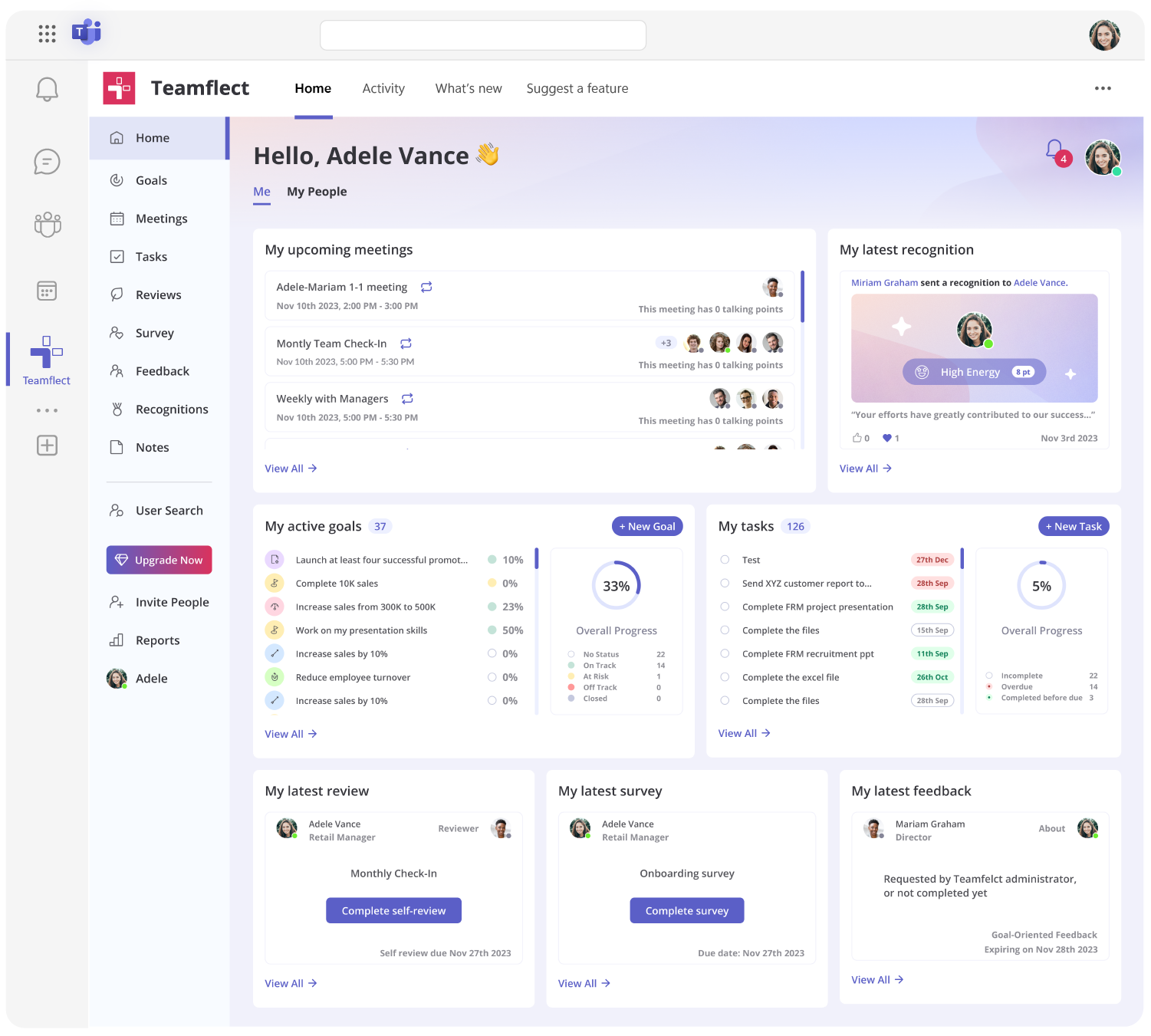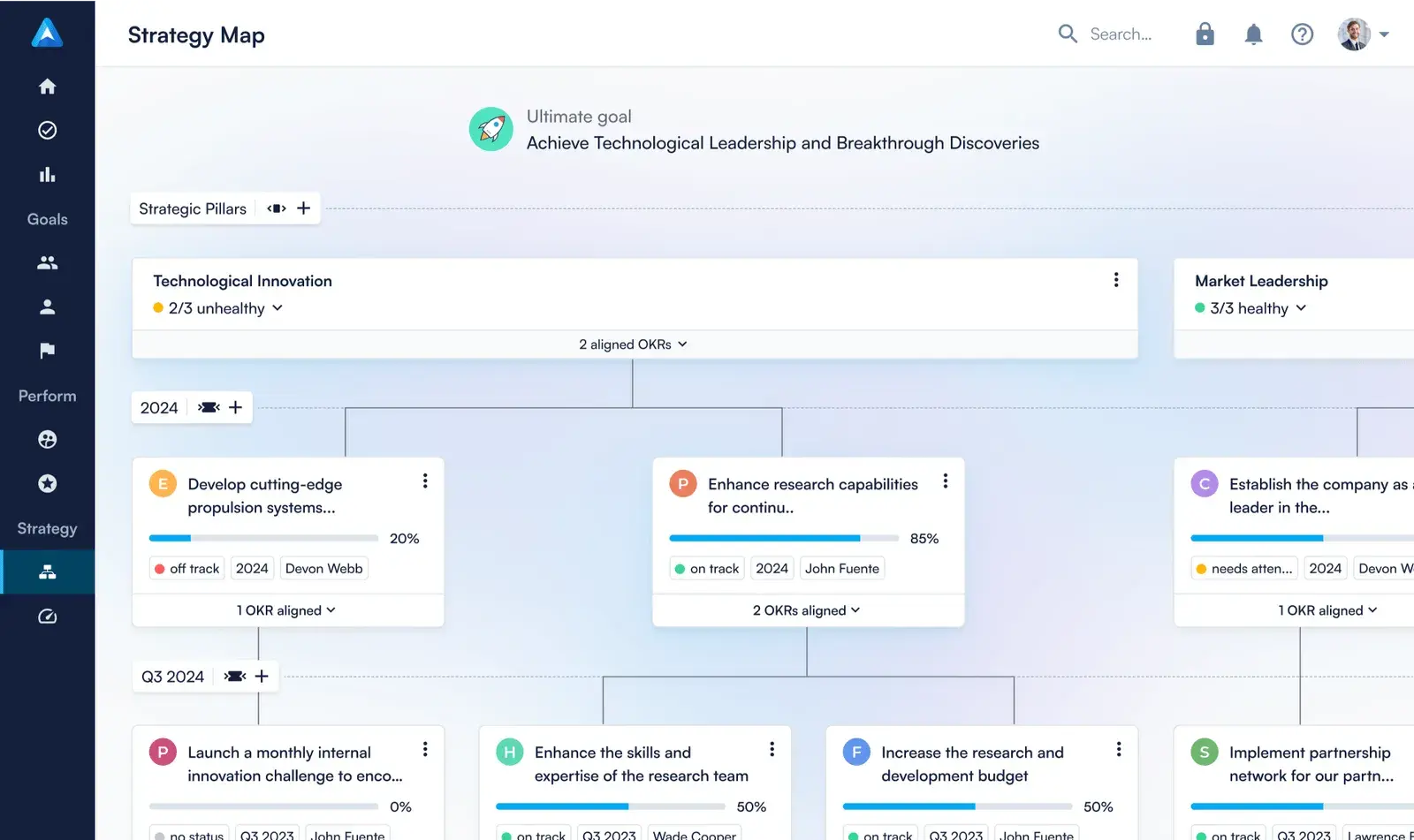Many teams find that Tability, while great for OKR tracking, offers almost no project management capabilities. This can be a problem, since most modern organizations need comprehensive solutions that combine goal management with performance reviews, employee feedback, and team engagement.
With Tability, users often find themselves juggling multiple platforms, making process management difficult. As such, users may want to find alternatives that can better fulfill their goal tracking and project management needs.
This guide examines the best Tability alternatives with all-in-one capabilities. We'll help you find a solution that scales with your team. Whether you need better integrations, complete performance management tools, or a platform to consolidate your HR tech stack, we've identified excellent options.
For organizations already utilizing Microsoft 365, Teamflect is the top choice. It offers native integration with Teams and Outlook, providing comprehensive performance management that Tability is yet to offer.

Tability focuses specifically on OKR management and goal tracking, providing teams with a streamlined approach to objective setting and progress monitoring. The platform emphasizes simplicity and clarity in goal management, making it accessible for teams new to OKR methodologies.
Key Features:
Pros: "The product is easy to use and has made reporting very easy and accurate." - Capterra Review
Cons: "Frequent layout updates and changes make it difficult to jump right in and do what needs to be done every time." - Gartner Peer Insights
Teams often outgrow Tability when they realize they need more than just OKR tracking. Common limitations include:

Teamflect transforms how organizations approach performance management by providing a comprehensive platform built specifically for the Microsoft 365 ecosystem. Unlike Tability's narrow focus on OKRs, Teamflect combines goal management with performance reviews, continuous feedback, and employee engagement tools, all accessible directly within Microsoft Teams and Outlook.
Organizations using Microsoft 365 are rapidly switching from limited OKR tools like Tability to Teamflect because it eliminates the need for multiple platforms. This OKR software integrates seamlessly into existing workflows, making adoption effortless for teams already comfortable with Microsoft tools.
Key Features:
Why Teams Switch from Tability to Teamflect:
Pros: "Teamflect has propelled our department to stand out within our division of the institution. We've accomplished more than 50% of our strategic plan within one year. That's pretty crazy. We were able to facilitate that because we were using a tool like Teamflect." - Customer Review by Furman University
Cons:
Pricing:

Perdoo specializes in strategic OKR management with visual strategy mapping capabilities. The platform helps organizations align objectives across all levels while maintaining clear visibility into how individual goals contribute to broader business outcomes.
Key Features:
Pros: "I like how Perdoo connects company objectives with individual key results, providing full visibility across the organization." - G2 Review
Cons: "There is a lack of flexibility in customizing dashboards, views, and overall reporting formats." - Capterra Review
Pricing:

Profit.co provides a comprehensive OKR platform that extends beyond basic goal tracking to include task management, performance reviews, and employee engagement features. The platform works particularly well for organizations using Google Workspace.
Key Features:
Pros: "Easy to use, intuitive product with custom ability. Graphical representation features set it apart from the likes. User management is easy." - Gartner Peer Insights
Cons: "Its extensive capabilities might feel overwhelming for simpler needs, though this can also be seen as room to grow.." - G2 Review
Pricing:

Quantive Results combines AI-powered strategy management with comprehensive OKR tracking. The platform emphasizes data integration and real-time insights to help organizations make informed strategic decisions.
Key Features:
Pros: "It's a great solutions that powers the OKRs. It includes all the features needed to deploy the strategy inside a company with a team without experience using the metodology." - G2 Review
Cons: "The navigation is probably my least favorite. I have a nav bar that includes our high level company, below that "All Teams", below that "All goals", and then my teams." - Capterra Review
Pricing:

Mooncamp offers a modern approach to OKR management with strong focus on team alignment and progress tracking. The platform provides good value for European organizations seeking GDPR-compliant solutions.
Key Features:
Pros: "Mooncamp helped in project management and enhanced collaborations." - Gartner Peer Insights
Cons: "Maybe because new features are released so often, sometimes you miss new functionalities that change a bit the behavior of the things that you used before." - Software Advice Review
Pricing:
Workpath focuses on enterprise-level OKR management with emphasis on strategic alignment and execution. The platform provides comprehensive tools for large organizations managing complex goal hierarchies.
Key Features:
Pros: "It helps a lot to make our goals transparent, to align all the teams, to track progress, identify impediments and achieve our goals." - Capterra Review
Cons: "For us as a relatively small company (<50), workpath is a heavy solution that comes with many features.” - G2 Review
Pricing:

Betterworks provides enterprise-level performance management with strong OKR capabilities. The platform combines goal management with comprehensive people development features for large organizations.
Key Features:
Pros: "Betterworks is a valuable user-friendly goal alignment tool to set and track OKRs." - Gartner Peer Insights
Cons: "The interface could be more intuitive and inviting, with features that encourage ongoing conversations rather than just ticking boxes." - G2 Review
Pricing:

Weekdone emphasizes weekly progress tracking and reporting, making it ideal for teams that prefer regular check-ins and status updates alongside their OKR management.
Key Features:
Pros: "I appreciate its highly configurable feature which I find particularly helpful in managing goals, objectives, and key results efficiently." - G2 Review
Cons: "Some users may find the interface to be somewhat cluttered or overwhelming, which can make it difficult to focus on important tasks." - Capterra Review
Pricing:

Lattice provides a comprehensive people management platform that includes strong OKR capabilities alongside performance reviews, engagement surveys, and development tools.
Key Features:
Pros: "Lattice is very easy to use - I use it weekly if not daily for my role and have been impressed with the functionality and features." - G2 Review
Cons: "It was quite confusing to fill up the goals and objectives and the way it needed to be updated was quite tedious." - Gartner Peer Insights
Pricing:

15Five combines OKR management with continuous feedback and performance check-ins, creating a comprehensive platform for ongoing performance management.
Key Features:
Pros: "Their regular check-ins and gold tracking have helped us stay focused and accountable." - Gartner Peer Insights
Cons: "A more streamlined or customizable dashboard would go a long way in improving the overall user experience." - G2 Review
Pricing:
Selecting the best alternative requires careful consideration of your organization's specific needs and circumstances. Here's a systematic approach to making the right choice.
Consider both your current team size and anticipated growth over the next 2 to 3 years. Some platforms excel with smaller teams but become expensive at scale, while others are designed for enterprise use and may be overcomplicated for smaller organizations. Performance tracking requirements often change as teams grow, so choose a solution that can scale with you.
While Tability focuses primarily on goal tracking, determine what additional capabilities you need. Many organizations discover they require performance review software, employee engagement survey tools, or comprehensive feedback systems.
Consider what to look for in performance review software if that's a priority, and evaluate whether you need features like 1-on-1 meeting management or talent development tools.
Pricing models vary significantly among alternatives. Some offer transparent per-user pricing while others require custom enterprise quotes. Factor in not just the monthly fees but also implementation costs, training requirements, and potential integrations. Many platforms offer free trials, so test multiple options before committing.
Consider your existing tech stack and determine which integrations are essential. If you're using Microsoft 365, solutions with native Teams integration provide the most value. Understanding the types of HRIS systems you currently use can also inform integration requirements.
The best platform is only effective if your team actually uses it. Consider your organization's comfort level with new tools and complex interfaces. Some alternatives offer sophisticated features but require significant training, while others prioritize simplicity and quick adoption. Use cases for AI agents in HR are becoming more common, so consider whether AI-powered insights would benefit your team.
Making the transition from Tability to a more comprehensive alternative requires careful planning and execution. Here's a step-by-step approach to ensure a smooth migration.
Begin by extracting all your existing goals, progress data, and historical information from Tability. Most platforms allow data export in common formats like CSV or Excel. Contact Tability's support team if you need assistance with bulk data extraction or have questions about data formats.
Timeline Develop a realistic timeline that allows for proper setup, data migration, and team training. Most organizations benefit from a 4-6 week transition period. Plan for overlap time where both systems run parallel, giving teams time to become comfortable with the new platform before fully switching over.
Communicate the reasons for switching and highlight the benefits of the new platform. Provide adequate training resources and consider identifying power users who can help support their colleagues during the transition. Address concerns proactively and gather feedback throughout the process.
Set up your organizational structure, user permissions, and goal hierarchies in your new system before importing data. This preparation ensures a smoother transition and reduces the likelihood of configuration issues after go-live.
Finding the right Tability alternative depends on your organization's specific needs and growth trajectory. While Tability serves its purpose as a focused OKR tool, most teams eventually require more comprehensive performance management capabilities.
The alternatives we've examined offer varying levels of functionality, from simple goal tracking to complete HR platforms with advanced features like AI-powered insights, performance reviews, and employee engagement tools.
For organizations using Microsoft 365, Teamflect emerges as the superior choice among Tability alternatives. This comprehensive performance management platform combines robust OKR tracking with performance review software, employee engagement survey capabilities, and native Microsoft Teams integration.
Unlike other solutions that treat Microsoft integration as an afterthought, Teamflect was built specifically for the Microsoft ecosystem, ensuring your team can manage goals, conduct reviews, and track performance without leaving their familiar workflow.
Teamflect offers the most comprehensive free alternative to Tability, supporting up to 10 users with no time restrictions and full functionality including OKR management, performance reviews, and Microsoft 365 integration. Other free options include Perdoo (5 users) and Profit.co (5 users), though these have more limited capabilities and user limits.
For small teams, Teamflect provides the best value with its generous free tier and comprehensive features. Perdoo and Profit.co also offer good options for smaller organizations, while enterprise-focused alternatives like Betterworks and Workpath may be overkill for teams under 50 people.
Yes, most Tability alternatives support data migration through CSV or Excel file imports. The process typically involves exporting your goals and progress data from Tability, then formatting it for import into your new platform. Teamflect and other providers often offer migration assistance to ensure smooth transitions.
Teamflect is specifically designed for Microsoft 365 users and offers native integration with Teams and Outlook. Unlike other alternatives that provide basic notifications, Teamflect allows you to conduct performance reviews, set goals, and track progress directly within Teams without switching platforms.
Most comprehensive Tability alternatives include performance review capabilities. Teamflect, Lattice, 15Five, and Betterworks all offer robust performance review systems, while others like Perdoo and Mooncamp provide limited or basic review features. Tability itself focuses solely on OKRs without performance review functionality.
An all-in-one performance management tool for Microsoft Teams
